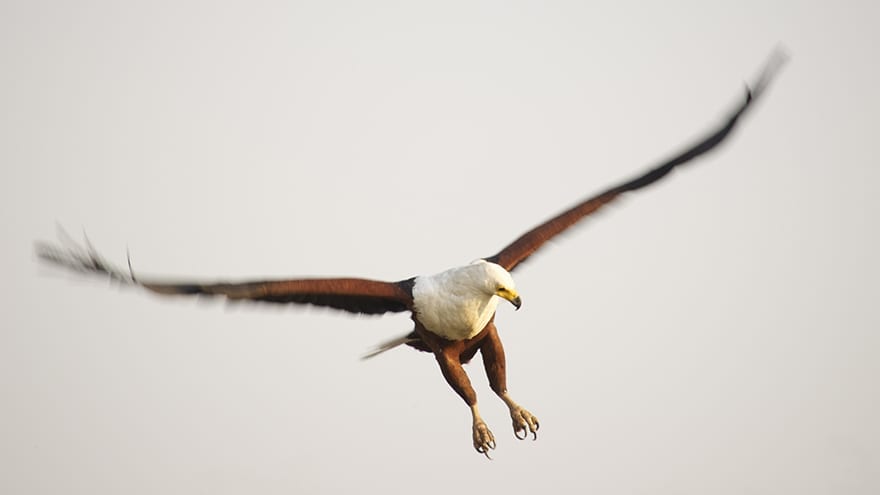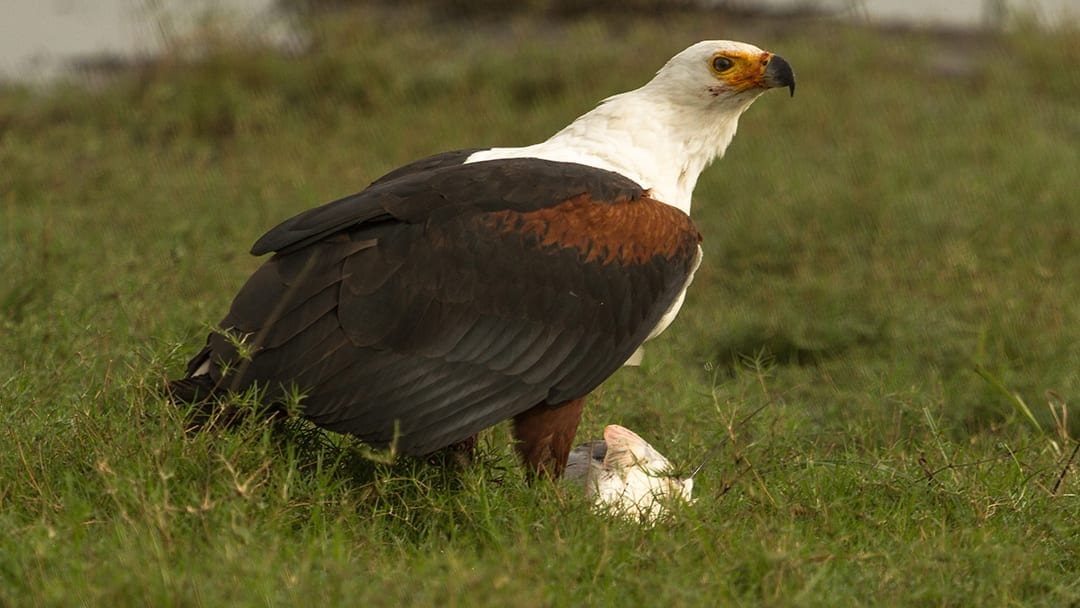Birds
When you ponder the animal kingdom, it’s hard not to marvel at the bird group – their prominence and diversity are difficult to match. Some birds are generalists, while others have very specific requirements on where they can live and what they can eat. Even in a single forest patch, you’ll find different birds feeding in the canopy, others beneath the canopy, and still others on the forest floor.
In 1965, 339 different bird species were recorded within Gorongosa National Park alone – not including Mount Gorongosa or surrounding areas. This is an indication of the exceptional biodiversity of the Gorongosa ecosystem.
The array of birds that you can see on a Mozambique safari in Gorongosa is simply breath taking. The best time of the year to see birds is November, when migratory birds arrive in Mozambique and resident birds have bright plumage for the breeding season. Over 150 different species may be recorded in a single day at this time of year. If you’re a serious birder, you know that Gorongosa is home a special bird that is found nowhere else in the world – the Green-headed Oriole.

African Fish Eagle
The African fish eagle (Haliaeetus vocifer) is known for its loud, distinctive call, which can be heard for miles before you can even see it. It is, for many, the sound evokes the essence of Africa. It’s said that once you’ve heard the fish eagle’s call, you never forget the sound.
Often seen perched on a riverbank tree, it feeds mainly on fish. When a potential meal is spotted, it will swoop down and snatch it from the water with its large clawed talons. The fish eagle’s diet is not just fish – it also may prey on water birds and eat their fill of carrion.
Often seen perched on a riverbank tree, it feeds mainly on fish. When a potential meal is spotted, it will swoop down and snatch it from the water with its large clawed talons. The fish eagle’s diet is not just fish – it also may prey on water birds and eat their fill of carrion.
Like most raptors, African Fish Eagles are believed to be monogamous and mate for life. Even so, the male must win the heart of the female each year, and this bird does it in quite a spectacular fashion. The pair meets in mid-air, locks talons and free-falls until they separate just above the ground. They do this over and over until they mate. Then it’s off to the nest they’ve called home for many years.

Green Headed Oriole
The Green-headed Oriole (Oriolus chlorocephalus), found only on Mount Gorongosa, tops the “most wanted” list of any serious birder. The bird that you’ll find on Mount Gorongosa is a unique race of Green-headed Oriole that is distinguished by the white panel on its wings. No other Green-headed oriole in Africa has this marking which makes it a unique find.
Green-headed Orioles, as a whole, are very specialized birds that can only be found in old-growth rainforests on mountaintops. They can be found in Kenya, Tanzania, and Mozambique but only in very few, special environments. It is believed that millions of years ago, when the earth’s climate shifted, this bird’s habitat was only left on a few isolated mountains topped in rainforest – such as Mount Gorongosa. As evolution occurred over millions of years, the Green-headed Oriole of Mount Gorongosa became it’s own unique race that is truly a once-in-a-lifetime sight.

Weaver
The weaver is truly the architect of the bird’s kingdom. They get their name from the fact that they weave their elaborately woven nests using fine leaf-fibers, grass, and palm leaves. Nests vary in size, shape, material used, and construction techniques from species to species. It is actually a nest within a nest, with the entrance at the bottom to protect the young birds from predators, especially the falcon.
These social birds often live together in noisy colonies, building their nests together for protection, often several to a branch. Usually it is the male that weaves the nest, using it as a form of display to lure prospective females. After constructing a nest, the male hangs beneath and displays singing and flapping. If a female accepts his invitation and moves in he begins building another nest to attract another female. If the female does not like the nest, he will tear it down and start over. If she does like the nest, she will line it with grass and feathers, and start raising a family.


Grey Crowned Crane
Tall, elegant Grey Crowned cranes (Balearica regulorum) are shy birds that live in wetlands. These cranes are known for their intricate dance that they do during the breeding season. As the displays pick up they perform ballet leaps of extraordinary beauty. The entire ritual involves dancing, bowing, jumping and head shaking. They also inflate their red throat pouch to produce honking sounds that are unique from the calls of other cranes.
They tend to mate for life, are very territorial and will defend their nesting area using these loud calls. They are also unique in that they cannot perch in the trees, unlike other cranes, because of their long hind toes.
This bird, with its magnificent golden crown, is a fairly common resident in Gorongosa, but is threatened elsewhere in the world. The Gorongosa ecosystem, along with the Zambezi delta, probably supports the greatest number of these magnificent birds in Southern Africa. As such, the wetlands of Gorongosa’s floodplain are of global importance.

Lilac Breasted Roller
Beautifully colored, the Lilac-breasted Roller (Coracias caudatus) has a virtual rainbow of feather colors. Sometimes confused with the Purple Roller (Coracias naevia), its distinguishing feature is its long, straight outer tail feathers.
It performs a wonderful courtship flight, with a fast dive from very high in the sky, with rolling (that’s where they get their name) or a fast rocking motion accompanied by loud raucous calls.
Monogamous and highly territorial, this attractive bird is one of the most commonly seen of the rollers. You can find them, atop a convenient perch, searching the area for a potential meal. It preys on grasshoppers, beetles, occasionally lizards, crabs, and small amphibians but is also known to take small birds. To feed, it swoops down from its perch next to its prey and eats it on the ground or brings it back to its perch where they batter it before swallowing it whole. Lilac-breasted Rollers don’t seem bothered by people one bit, allowing you to get very close for a good photo.
Our Mission
Our Mission
Advance an integrated multi-partner approach to conservation and to people-centred development. The Gorongosa Project protects the Park’s biodiversity and ecosystem services and unlocks its economic potential for the community inhabitants of the Gorongosa Buffer Zone, Sofala Province, Mozambique and further afield.
Our Vision
A thriving, biodiversity-rich, Greater Gorongosa conservation landscape, which supports Sofala Province as an engine for resilient and sustainable development enabling nature experiences and wellbeing for its people, enriching all of Mozambique and the world.
A Park for Peace
On 1 August, 2019 a historic ceremony was held in Gorongosa to celebrate the Cessation of Hostilities Accord between the leaders of the Government of Mozambique and the opposition Renamo Party. The accord established Gorongosa National Park (GNP) as a ‘Park for Peace’, delivering human development to the communities that share the greater landscape.